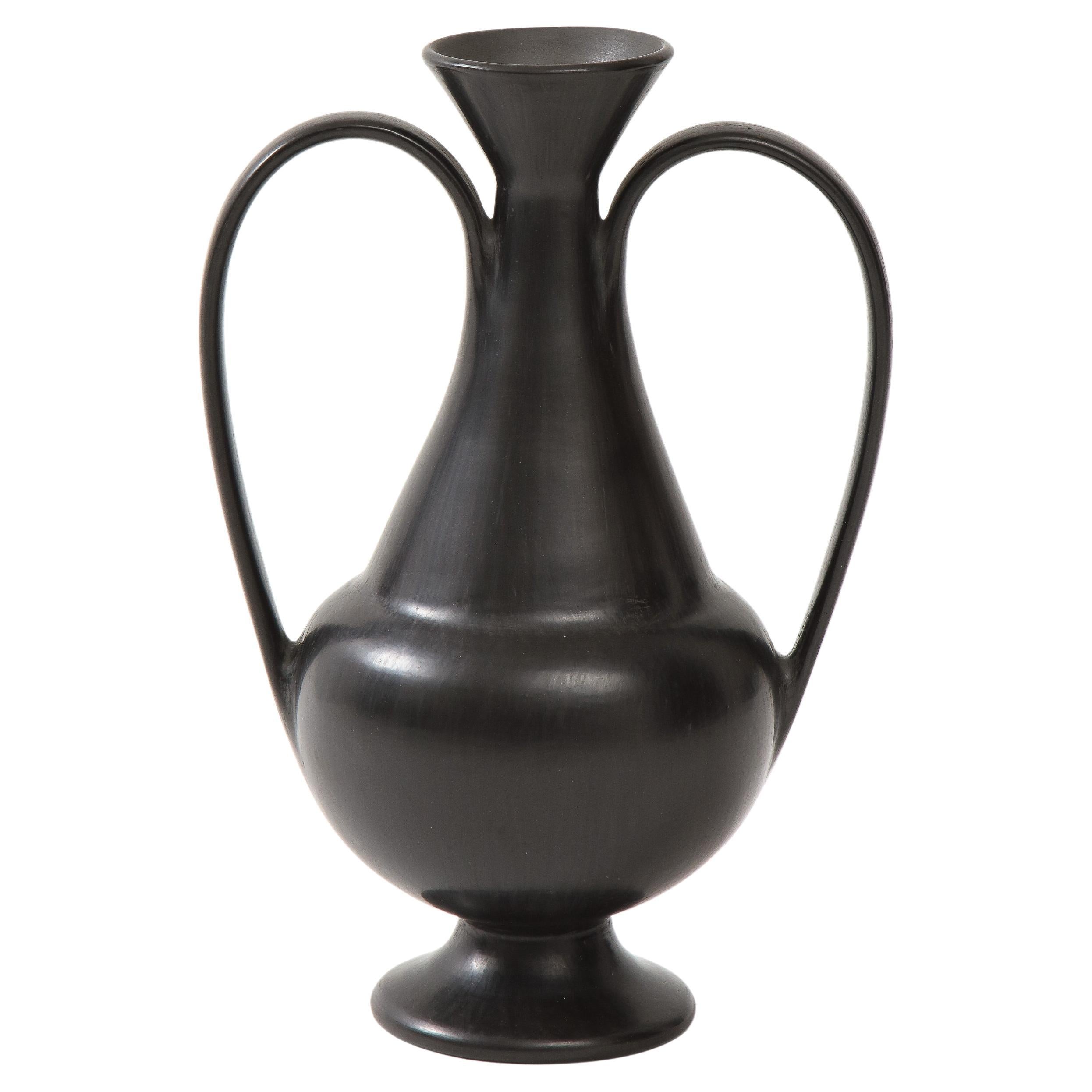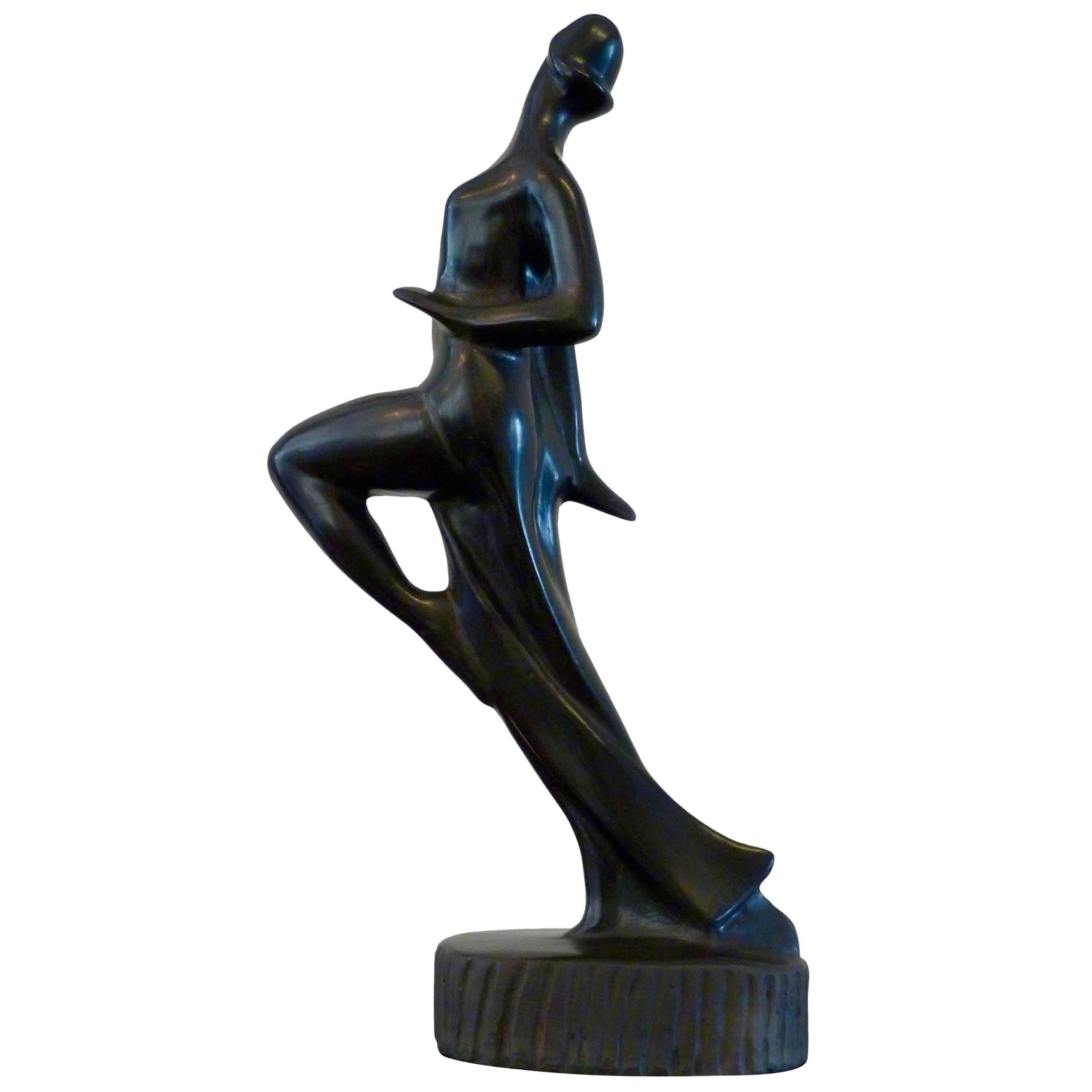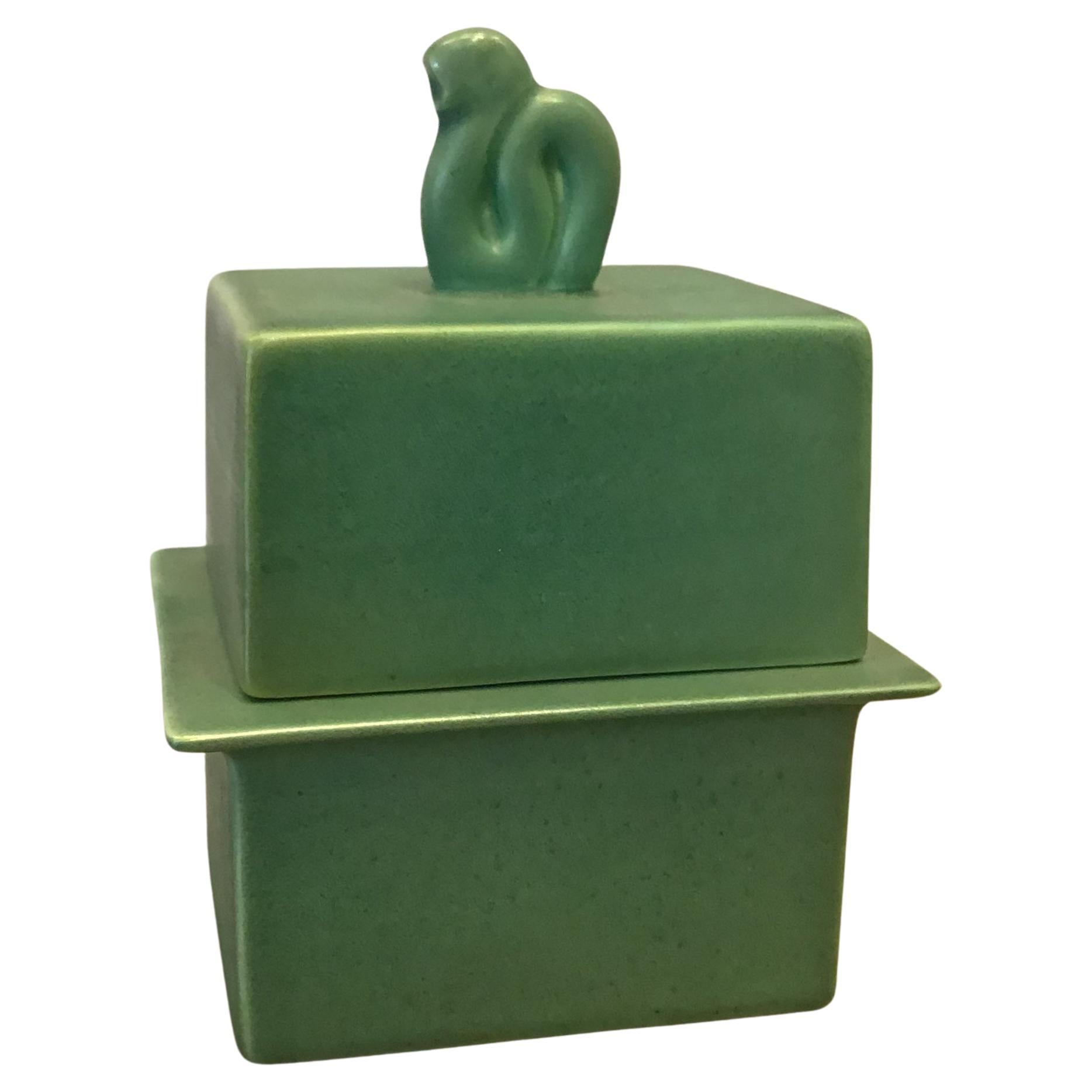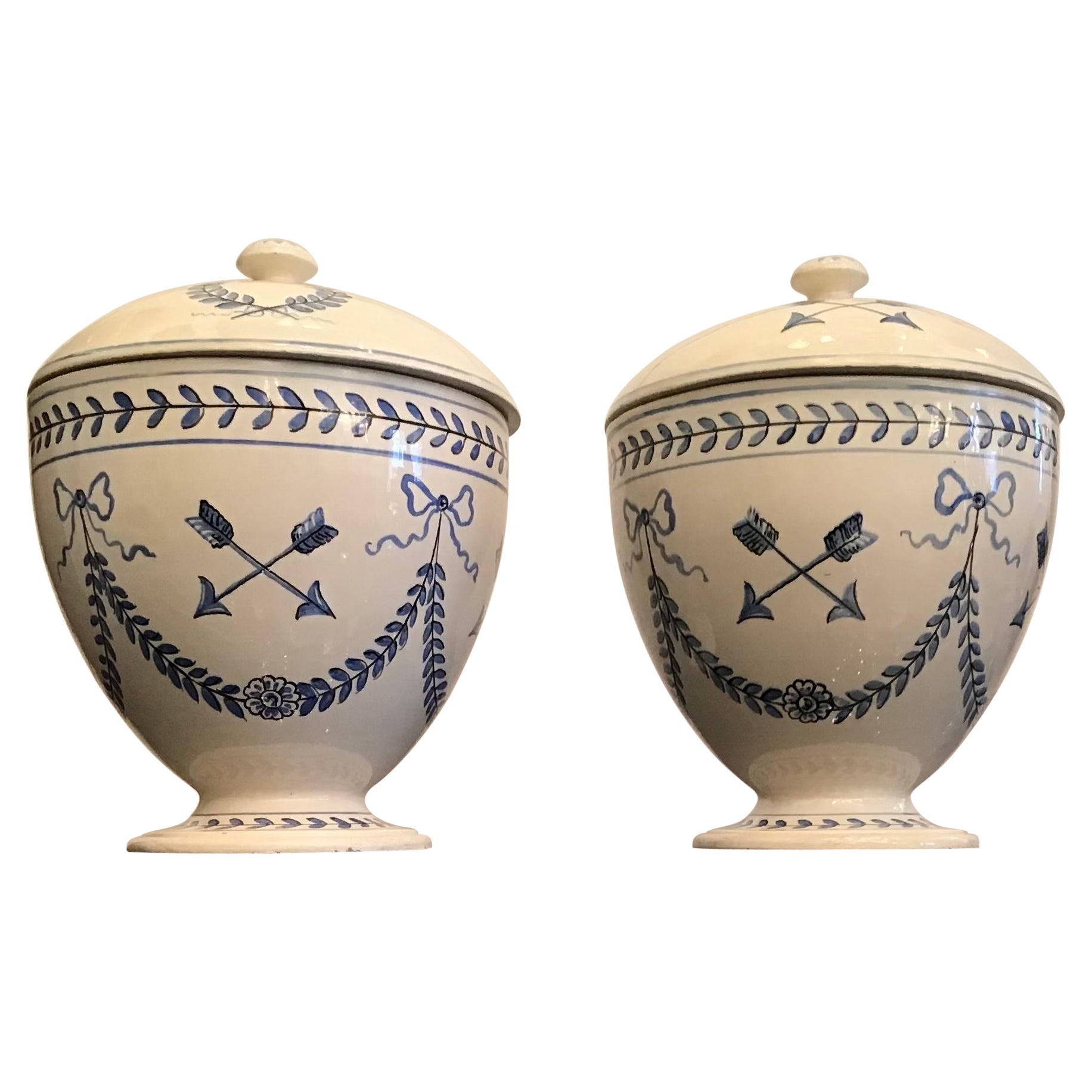Items Similar to Italian Ceramic Saucers "Bucchero" by C.A. Rossi Gio Ponti Style Gubbio
Want more images or videos?
Request additional images or videos from the seller
1 of 18
Italian Ceramic Saucers "Bucchero" by C.A. Rossi Gio Ponti Style Gubbio
About the Item
We kindly suggest you read the whole description, because with it we try to give you detailed technical and historical information to guarantee the authenticity of our objects.
Iconic ceramic "Buccheri" saucers with a small base (2 pieces); the “bucchero” is a type of black and shiny pottery, often fine and very light, produced by the Etruscans to make domestic furnishings and decorative objects; the "bucchero" was used in Etruria from the second quarter of the 7th century BC-the first half of the 5th century BC; the black monochrome integral is the most evident feature of this type of pottery and the coloring was obtained through a particular firing; the term "bucchero" comes from the Castilian "bùcaro", with which they defined some vases arrived from South America more or less in the same period of the first findings in Etruscan archaeological sites. In the "bucchero" is black both the mixture and the surface, which is shiny and compact. The color is not obtained by painting but thanks to a special firing process in the absence of oxygen, which prevents the chemical transformations of oxidation that make it take on the typical orange coloring to the iron ores contained in the clay. Our "Buccheri" saucers were made by Carlo Alberto Rossi (1903-1970) in his workshop in Via Savelli Della Porta in the historic center of Gubbio (Italy) and bear the artist's signature on the bottom; the laboratory "Buccheri Antonio Rossi" draws its origins from the innovative activities in the field of ceramics and in the technique of "bucchero" in particular, which characterized the manufacture "Fratelli Rossi di Gubbio", started by Carlo Alberto and Antonio Maria Rossi in 1932. The search for new balances and purity of form has always distinguished the activity of this manufactory; some of the various collections that characterize the work of the workshop include models by the famous architect Gio Ponti (1891-1979), expressly requested by Carlo Alberto in the 1950s. Our saucers produced between 1950 and 1955, are a work born in the period of this important collaboration and are inspired by the style of the famous Italian architect; the two elegant and delicate subjects are inspired by Hellenistic models, they have been made with graffito decorations, pure gold leaves and polished. The saucers, produced with an ancient and unique technique, combine classicism and design, an example of exquisite beauty and superb quality. Many works from this workshop are found in various museums around the world and have received several national and international awards. On the edge of the saucer with the two figures, there is a perfect repair of the time (see photo). Measures: Diameter cm. 17, height cm. 3. For all our shipments we use special packaging materials (wooden crates, styrofoam, etc.) for maximum protection and safety of the objects.
- Dimensions:Height: 1.19 in (3 cm)Diameter: 6.7 in (17 cm)
- Sold As:Set of 2
- Style:Hellenistic (In the Style Of)
- Materials and Techniques:
- Place of Origin:
- Period:
- Date of Manufacture:1950-1955
- Condition:Wear consistent with age and use. On the edge of the saucer with the two figures, there is a perfect repair of the time (see photo).
- Seller Location:Prato, IT
- Reference Number:
About the Seller
5.0
Gold Seller
These expertly vetted sellers are highly rated and consistently exceed customer expectations.
Established in 1977
1stDibs seller since 2019
235 sales on 1stDibs
Typical response time: 4 hours
- ShippingRetrieving quote...Ships From: Prato, Italy
- Return PolicyA return for this item may be initiated within 14 days of delivery.
More From This SellerView All
- Bitossi By Aldo Londi Italian Vintage Glazed Ceramic VaseBy Aldo Londi, BitossiLocated in Prato, TuscanyWe kindly suggest that you read the whole description, as with it we try to give you detailed technical and historical information to guarantee the authenticity of our objects. Iconi...Category
Mid-20th Century Italian Mid-Century Modern Ceramics
MaterialsCeramic
- Rockabilly Style French Centrepiece Red and Black CeramicLocated in Prato, TuscanyWe kindly suggest you read the whole description, because with it we try to give you detailed technical and historical information to guarantee the authenticity of our objects. Red and black ceramic table centerpiece made in Rockabilly style, the colors are strong and decisive, the black has the distinction of having beautiful reflections nacreè (mother of pearl), reflections that unfortunately the photos can not capture, from life are really seductive, the form is nicely undulating, pleasant and very capacious; the centerpiece was produced between 1950 and 1953, by skilled artisans in the area of Vallauris, the "French city of ceramics" in Provence north-east of Cannes, renowned since ancient times for the production of this fascinating material; there were more than 250 production centers, but today very few remain and since the mid-20th century, they are dedicated to the manufacture of contemporary ceramics. The word "Rockabilly" is a combination of "rock and roll" and "hillbilly" (a derogatory term used to define the Appalachian mountain people and, in a generic sense, meant country boor); Rockabilly was a musical genre developed in the early 1950s, it was one of the first forms of rock & roll. It was a fusion of bluegrass, country, boogie-woogie, and jazz, originally from the southern United States, and was played and sung by artists such as Buddy Holly...Category
Mid-20th Century French Modern Ceramics
MaterialsCeramic
- Fat Lava Style German Colored Ceramic Glazed VaseLocated in Prato, TuscanyWe kindly suggest you read the whole description, because with it we try to give you detailed technical and historical information to guarantee the authenticity of our objects. Particular and original German ceramic vase colored with a beautiful shade of red and a dark and vivid black; it has a simple shape but at the same time innovative and modernist; the beautiful and bright colors are balanced and proportioned respecting a minimalist design; the glazing of the vase was obtained by first laying down one color, proceeding to fix it by firing it in the kiln, then the same procedure was carried out for the other color; on the bottom is the mark "W. Germany"; it was produced between 1968 and 1971 in a craft workshop in the city of Dresden (then in East Germany), an important center for the production of porcelain and ceramics. "Fat lava" is the name given to a certain style of East German art...Category
Late 20th Century German Brutalist Vases
MaterialsCeramic
- Fat Lava Brutalist Style Hungarian Colored Ceramic Glazed VaseLocated in Prato, TuscanyWe kindly suggest you read the whole description, because with it we try to give you detailed technical and historical information to guarantee the authenticity of our objects. Pecul...Category
Mid-20th Century Hungarian Brutalist Ceramics
MaterialsCeramic
- Bertoncello Italian Sculpture Vase Glazed Ceramic Design Roberto RigonBy Roberto Rigon, Giovanni BertoncelloLocated in Prato, TuscanyWe kindly suggest you read the whole description, because with it we try to give you detailed technical and historical information to guarantee the authenticity of our objects. Inno...Category
Late 20th Century Italian Mid-Century Modern Vases
MaterialsCeramic
- Deruta Italian Ceramic Set Three Hand Painted Wall PlatesBy DerutaLocated in Prato, TuscanyWe kindly suggest you read the whole description, because with it we try to give you detailed technical and historical information to guarantee the authenticity of our objects. Three delightful and colorful round ceramic wall plates; they were created completely by hand between 1965 and 1968 by a small artisan workshop in Deruta (Perugia, Italy) respecting ancient traditions and raw materials; clay, enamel, colors, water, fire and the hands of the artist: these are the simple elements that lead to the creation of a ceramic article; on the back they have two holes so they can be hung on the wall; they represent characters in Renaissance clothing, each in a different pose: the first is a swordsman who wields a special weapon of the time the "side sword" with S-shaped guard and a dagger with guard very elaborate, useful to trap the blade of the opponent; the "spada da lato" (side sword) is that elegant and handy sword that, from the second half of the fifteenth century and throughout the sixteenth century, is worn on the belt by nobles or rich, a weapon designed for self-defense or to be used in a duel; In fact the second plate represents just a duel in which the two contenders always use "swords side", the one on the left also has a small shield and the one on the right wields an effective and perfidiously fast double-edged dagger; In the third plate is painted a "naccarino" who plays a cylindrical drum (similar to those spread by the Lanzichenecchi from the fifteenth-sixteenth century) held on the side and beaten with two sticks, the "naccarini" were players of small instruments whose presence was required every time you had to give particular solemnity to a public event. We don't know why the people of Deruta began to work the terracotta and to produce vases and manufactured articles in ceramics but we know with all certainty that already in the Middle Ages the city was known for the production of ceramics of high quality, the first written sources make to date the ceramics of Deruta (Perugia) to 1282. In the Renaissance, they were active to Deruta more than fifty furnaces with which they collaborated artists like the Perugino, the Pinturicchio, and Luca Signorelli. The mastery of the artisans and artists of Deruta ceramics...Category
Mid-20th Century Italian Medieval Ceramics
MaterialsCeramic
You May Also Like
- Gio Ponti and Carlo Alberto Rossi Rare Bucchero Ceramic Vase, Italy, 1950sBy Gio PontiLocated in New York, NYGio Ponti and Carlo Alberto Rossi rare classical Bucchero ceramic vase with two handles, Italy, circa 1951. Signed C. A. Rossi under the base. Bu...Category
Vintage 1950s Italian Mid-Century Modern Vases
MaterialsCeramic
- Gio Ponti Design for "Manifattura Rossi" A Bucchero Female Nude SculptureBy Gio PontiLocated in CHCarlo Alberto Rossi (Gubbio 1903-1970), Manifattura Rossi a Bucchero Female Sculpture after a Gio Ponti drawing, signed C. A. Rossi, circa 1940 Gio Ponti in the 1940s collaborated w...Category
Vintage 1950s Italian Mid-Century Modern Figurative Sculptures
MaterialsCeramic
- Gio’ Ponti Scattola Ceramic 1930 ItalyBy Gio PontiLocated in Milano, ITBox Richard Ginori “ Gio’ Ponti”Category
Mid-20th Century Italian Art Deco Ceramics
MaterialsCeramic
- Gio’ Ponti Box Ceramic 1927 ItalyBy Gio PontiLocated in Milano, ITBox Gio Ponti 1930Category
Vintage 1920s Italian Art Deco Ceramics
MaterialsCeramic
- Gio’ Ponti “Stile” Potiche Ceramic 1950 ItalyBy Gio PontiLocated in Milano, ITGio ‘ Ponti “Style “ Potiche Ceramic 1950 Italy.Category
Vintage 1950s Italian Other Ceramics
MaterialsCeramic
- Gio' Ponti Richard Ginori Vase Ceramic 1930 ItalyBy Gio PontiLocated in Milano, ITVase / Vase Holder Richard Ginori Gio PontiCategory
Vintage 1930s Italian Other Ceramics
MaterialsCeramic
Recently Viewed
View AllMore Ways To Browse
Featured Ceramics
Leaf Ceramics
Repaired Ceramics
Silver Safety
Engraved Glasses Gold
Black And Gold Ceramics
Fire Light Glass
Vintage Field Glasses
Bc Vintage
Vintage Glasses Search
Vintage Glass Search
Italian Fine Ceramics
Fire And Light Glass
Gold Saucer
Classicism Style
Compacts 1950
Integral Gold
Silver Compact





